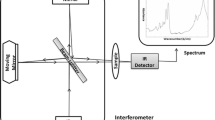Abstract
Recently, deoxyribonucleic acid (DNA) based biomarker(s) detection has been employed for cancer diagnosis. Earlier reports have suggested the presence of more DNA in the saliva of oral squamous cell carcinoma (OSCC) than normal by electrophoresis technique. Based on these, steady state and excited state kinetics of salivary DNA has been performed with 27 normal subjects and 67 OSCC patients saliva using ethidium bromide as a probe to look for the possibility in discrimination between them. On statistical analysis the sensitivity and specificity of 88.9 and 94.0 % has been achieved from the fluorescence emission spectra and 88.9 and 92.5 % with that of fluorescence excitation.






Similar content being viewed by others
References
The international statistical classification of diseases and related health problems (1992) Geneva. World Health Organization 10th Ed
Cancer Facts and Figures (2007) Atlanta. American Cancer Society
Ravindran R, Deepa MG (2012) Salivary tumour markers in oral cancer: brief review. Oral Maxillofac Pathol J 2:238–244
Markopoulos AK, Michailidou EZ, Tzimagiorgis G (2010) Salivary markers for oral cancer detection. Open Dent J 4:172–178
Coelho KR (2012) Challenges of the oral cancer burden in India. J Cancer Epidemol Article ID 701932: 1–17. doi: 10.1155/2012/701932
Madhuri S, Vengadesan N, Aruna P, Koteeswaran D, Venkatesan P, Ganesan S (2003) Native fluorescence spectroscopy of blood plasma in the characterization of oral malignancy. Photochem Photobiol 78(2):197–204
Hansen TVO, Simonsen MK, Nielsen FC (2007) Collection of blood, saliva, and buccal cell samples in a pilot study on the Danish nurse cohort: comparison of the response rate and quality of genomic DNA. Cancer Epidemiol Biomarkers Prev 16:2072–2076
Rajasekaran R, Aruna PR, Koteeswaran D, Bharanidharan G, Baludavid M, Ganesan S (2014) Steady-state and time-resolved fluorescence spectroscopic characterization of urine of healthy subjects and cervical cancer patients. J Biomed Opt 19(3):037003
Shpitzer T, Hamzany Y, Bahar G, Feinmesser R, Savulescu D, Borovoi I, Gavish M, Nagler RM (2009) Salivary analysis of oral cancer biomarkers. Br J Cancer 101(7):1194–1198
Bahar G, Feinmesser R, Shiptzer T, Popovtzer A, Nagler RM (2007) Salivary analysis in oral cancer patients: DNA and protein oxidation, reactive nitrogen species, and antioxidant profile. Cancer 109(1):54–59
Viet CT, Schmidit BL (2008) Methylation array analysis of preoperative and postoperative saliva DNA in oral cancer patients. Cancer Epidemiol Biomarkers Prev 17:3603–3611
Yuvaraj M, Udayakumar K, Jayanth V, Prakasa Rao A, Bharanidharan G, Koteeswaran D, Munusamy BD, Krishna CM, Ganesan S (2014) Fluorescence spectroscopic characterization of salivary metabolites of oral cancer patients. J Photochem Photobiol B 130:153–160
Sugimoto M, Wong DT, Hirayama A, Soga T, Tomita (2010) Capillary electrophoresis mass spectrometry-based saliva metabolomics identified oral, breast and pancreatic cancer-specific profiles. Metabolomics 6:78–95
Byrne CD, de Mello AJ (1998) Photophysics of ethidium bromide complexed to ct-DNA: a maximum entropy study. Biophys Chem 70:173–184
Vardevanyan PO, Antony AP, Parsadanyan MA, Davtyan HG, Karapetyan AT (2003) The binding of ethidium bromide with DNA: interaction with single-and double-stranded structures. Exp Mol Med 35(6):527–533
Cosa G, Focsaneanu KS, McLean JRN, Mc Namee JP, Scaiano JC (2001) Photophysical properties of fluorescent DNA-dyes bound to single- and double-stranded DNA in aqueous buffered solution. Photochem Photobiol 73(6):585–599
Olmsted J III, Kearns RD (1977) Mechanism of ethidium bromide fluorescence enhancement on binding to nucleic acids. Biochemistry 16(16):3647–3654
Wahl P, Paoletti J, Le Pecq JB (1970) Decay of fluorescence emission anisotropy of the ethidium bromide-DNA complex evidence for an internal motion in DNA. Proc Natl Acad Sci U S A 65(2):417–421
Salem MMAEL, Shalbaf M, Gibbons NCG, Chavan B, Thornton MJ, Schallreuter KU (2009) Enhanced DNA binding capacity on up-regulated epidermal wild-type p53 in vitiligo by H2O2-mediated oxidation: a possible repair mechanism for DNA damage. FASEB J Res Commun 23:3790–3807
Modica-Napolitano JS, Singh KK (2002) Mitochondria as targets for detection and treatment of cancer. Expert Rev Mol Med 4(9):1–9
Dragan AI, Bishop ES, Casas-Finet RJ, Schenerman MA, Geddes CD (2009) Metal-enhanced ethidium bromide emission: application to dsDNA detection. Chem Phys Lett 480:296–299
Keskinova E, Angelov D, Angelova SV, Shaqiri Z, Veseli A (1998) Effects of high-intensity UV radiation on isolated and DNA-intercalated ethidium bromide. Fizika A 7:17–26
Acknowledgments
The work was supported by DAE-BRNS Grant (Ref. No. 2009/34/38), Govt. of India. The author, M. Yuvaraj acknowledges DST-PURSE for fellowship. We acknowledge Dr. S. Sri Priya and Mrs. Arivazhagi of Government Arignar Anna Cancer Hospital, Regional Cancer Centre, Karapettai, Kanchipuram, for providing the samples and the histopathological reports.
Author information
Authors and Affiliations
Corresponding author
Rights and permissions
About this article
Cite this article
Yuvaraj, M., Aruna, P., Koteeswaran, D. et al. Rapid Fluorescence Spectroscopic Characterization of Salivary DNA of Normal Subjects and OSCC Patients Using Ethidium Bromide. J Fluoresc 25, 79–85 (2015). https://doi.org/10.1007/s10895-014-1482-0
Received:
Accepted:
Published:
Issue Date:
DOI: https://doi.org/10.1007/s10895-014-1482-0




